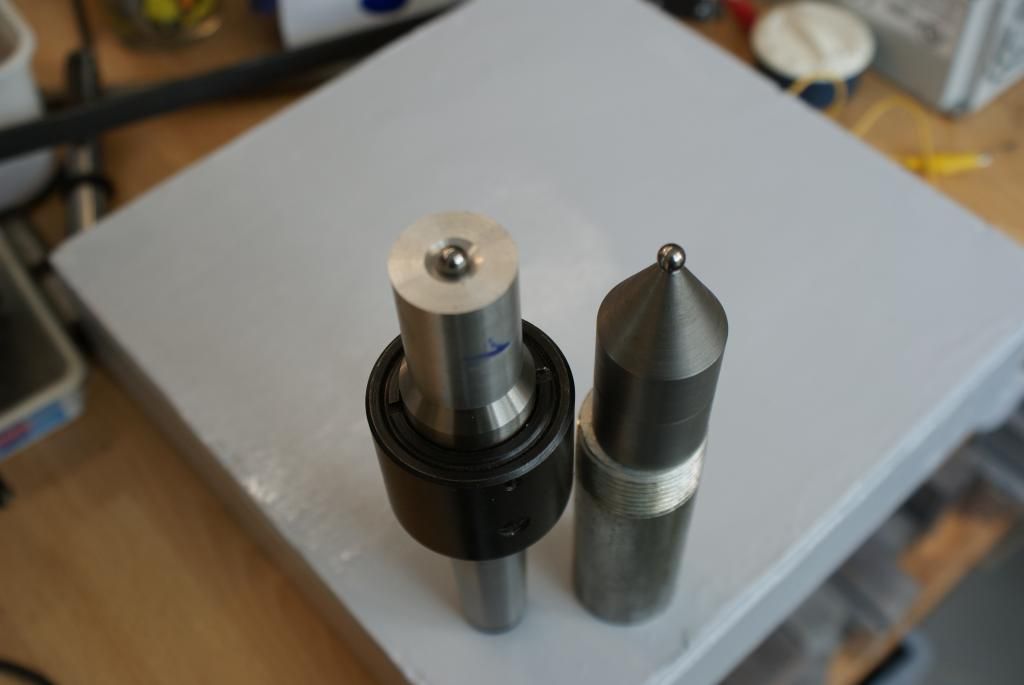These work piece were about 15" in length and about 1.500 in diameter. They were lightweight shafts. The reason why I was using a dead, half center and not a live center was because I was to face the finish face the ends square. These are Navy Shafts and I they want the faces to be square to the O.D. within .0005 or .0002, I can't recall which one.
I'm going to try that method of using the tailstock hand wheel imbalance to keep pressure on the work piece, and try not using the quill lock. I did look in my book "How to Run a Lathe" by South Bend for the leather lace idea. Also I looked in my book "Running an Engine Lathe" by Fred H. Colvin. All I saw in both books about the leather lace is, like Mike C. said, about holding a drive dog and shaft back against a faceplate and headstock center while using a steady rest.
I did turn on a dead center again last night and didn't have trouble with the work piece becoming too loose between centers. The shafts I was running last night were about the same size, however, these shafts didn't have the very small center hole in the one end, they had a larger center hole. In the book by Fred Colvin that I was reading it says, "Size of Center - If it is tool steel and is to be hardened, make the hole and the center as small as can be done with safety, but not small enough to cut the lathe center or prevent the piece being held steadily." In the one type of shafts I was working on, I think the center holes were too small, therefore it was cutting into my soft, headstock center.
In post #18 I suggested this was most likely the problem. It's not that they're "too small" it's that they're not deep enough. The tip of the centre should sit in the pocket formed by the tip of the centre drill. If it's not drilled deep enough the tip will instead bottom out in that pocket, the centre both won't run correctly and will loosen with use. From what you initially wrote I'd suggest the centre drill you were using was WAAAAAY too big. It will depend precisely on the type of work you're doing, but extrapolating from the tolerance figures you mentioned I'd probably centre drill shafts this size with a #3 (??), you may even be able to get by with a #2. I think from memory you were using a #7!!
I don't want to tell you how to suck eggs, but there is a "correct" depth to drill a centre; not too shallow and not too deep. If you want a smaller centre hole, you don't just use the same centre drill and drill less deep (as it sounds as if you've done), you use a smaller centre drill. Drill down until you're approaching the centre drill diameter, but don't over-drill it so that it's boring the hole. If you do that you'd have the opposite problem and the centre will ride on the rim of the hole.
I'd consider it highly unlikely it was your headstock centre causing the problem. Admittedly both headstock and tailstock centres should be drilled correctly, but any problems normally manifest themselves at the tailstock end.
As mentioned, pretty much any lubricant can be used but some are better than others. White lead was, I believe (before my time) traditionally used and I understand was excellent for this purpose. There's no good reason to use EP type lubricants as the temperatures and pressures in this application won't be sufficient to activate the EP additives which require localised high pressure/temperatures to work. If I really wanted to give a toss what I used I'd probably go for something with a graphite additive, as it works well at these low pressure and temperature applications. Fortunately I don't really give a shit, do work just fine using dead centres, and so far no two headed babies have been born in my household as a result.
Anyway, the bottom line sounds as if you need to invest in a set of decent "center" drills (because you guys can't spell). I'd
strongly suggest you don't cheap out on them either. Buy good quality ones as below about a #3 the drill diameter (ie the tip part) gets pretty small and they're easy to snap off, especially if you're drilling tougher material. If it snaps off you'll often scrap the work. Not that, errr, I'm speaking from experience in that area



 ) as the work heats up, especially on long skinny work....that force has to go somewhere. I set it so the work can be moved by hand but doesn't floppy around. No clanging or clatter
) as the work heats up, especially on long skinny work....that force has to go somewhere. I set it so the work can be moved by hand but doesn't floppy around. No clanging or clatter

 Bob
Bob




